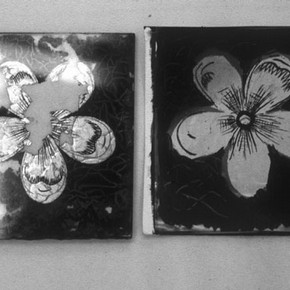Conservation Journal
Autumn 2001 Issue 39
Reverse painting on glass in the British Galleries

Figure 1. The panel (left) prior to attaching the 3 backing sheets (right). Photography by Fi Jordan (click image for larger version)
A reverse painting on glass relies on light reflected from its surface for its unique appearance. It therefore differs from stained glass with translucent colours viewed by transmitted light. Examples in the new galleries include small panels inserted into a three-dimensional object, pictorial works and decorative borders. Although there is diversity in the origin, execution and style of applying colour to glass, the physical problems of paint on a glass substrate remain essentially the same.
Unfired and inherently fragile paint and metal leaf is weakly attached to the reverse of the glass. Alongside degradation from mechanical damage, there are adhesion problems from the use of poor binding mediums and adverse reactions to fluctuations in relative humidity. As the paint layers age, they begin to lift, leaving a gap between the glass and paint, significantly distorting its appearance. Eventually flakes may detach from the surface. This is especially true of objects in unsuitable environmental conditions and where paint is thickly applied.
The objects chosen for the new galleries all displayed some degree of degradation. Treatments to stabilise the unfired decoration are highly intrusive. Traditional, current and new treatment methods were evaluated. The objects requiring immediate treatment were identified alongside those to be considered for future treatment or research. All the objects were made structurally sound, e.g. broken glass was bonded and mounts and supports secured.
Consolidation was undertaken if decorative layers were unstable or actively flaking. A small painting backed with metal foil depicting the Great Exhibition (CIRC.801- 1969 in Gallery 122) displayed localised flaking. After testing a number of consolidants, a low viscosity resin, Aquazol 500 (poly(2-ethyl-2-oxazoline)10% (w/v) in Industrial Methylated Spirits, was chosen.1 It was introduced by brush to the gap between the lifting paint and glass. Slight pressure was applied to the painting during solvent evaporation.2
Aquazol 500, 20% (w/v) in water and IMS (95:5), was also used to reattach flakes on a small painted and gilded corner panel bordering a large nineteenth century painting on glass from Guangzhou, China (P.11:1-1936 in Gallery 120). Over one-third of the decoration on the corner panel had detached with extensive cleavage and actively flaking paint. Areas of loss were not in-painted but reproduced on layered backing sheets: one sheet of Melinex contains the outlined design, another is water gilded with gold leaf and a third is acid free card coloured with acrylic paint. These were attached to the original glass and sealed around the edges with goldbeater’s skin (figure 1).
The conservation of friable materials continues to present a challenge to conservators. In this case, problems are exacerbated by the juxtaposition of materials used to create the objects. Further collaboration between conservation disciplines can only help increase our understanding of the unique qualities and inherent fragility of paintings on glass.
References
1. Wolbers, R.C., McGinn, M., Duerbeck, D., Poly (2-ethyl-2-oxazoline): A New Conservation Consolidant, Painted Wood History and Conservation. Proceedings of the Symposium organised by the Wooden Artefacts Group of AIC, 1994, Williamsburg.
2. Sundström, R., Conservation Report: Reverse painted glass ‘Crystal Palace’ detailing work undertaken by Ricard Sundström, RCA/V&A Conservation Student, April 2001
Autumn 2001 Issue 39
- Editorial
- A concise approach: Managing information for the British Galleries Conservation Programme
- Reverse painting on glass in the British Galleries
- Book display in the British Galleries
- Too big for his boots - Relocation of the Wellington Monument model
- Overview of the gilded objects treated for the British Galleries
- East meets West: The Althorp Triad
- A gun-shield from the armoury of Henry VIII: Decorative oddity or important discovery?
- Conservation or restoration? Treatment of an 18th century clock
- The British Galleries project from a paintings conservation perspective
- Chinese wallpapers in the British Galleries
- Censer: Making Sense of an Object
- Ephemeral or permanent? Illuminating the Bullerswood carpet
- Conservation of a crewelwork bed curtain
- Printer friendly version